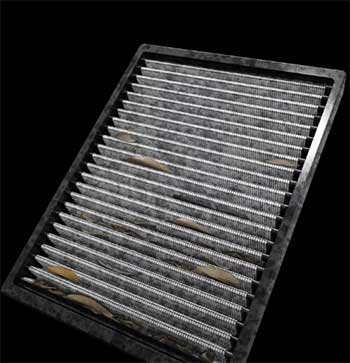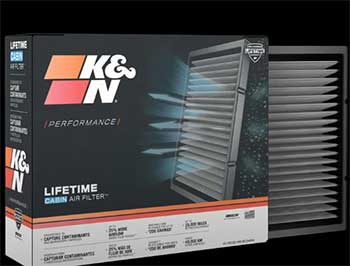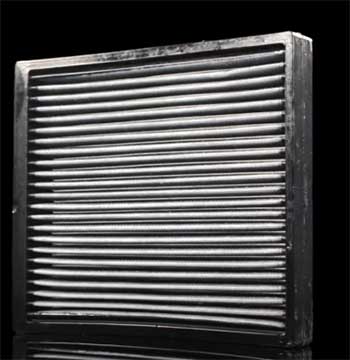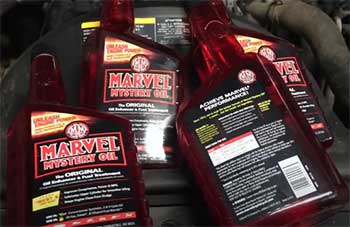Picture this: you’re cruising down the highway, windows up, AC blasting, and the air inside your car feels crisp, clean, and odor-free. That’s the promise of a K&N cabin air filter, and I’m here to tell you it’s a game-changer.
If you’re tired of musty smells or weak airflow from your car’s HVAC system, this washable, reusable filter is your ticket to fresher air and a happier drive. Trust me, once you try it, you’ll wonder why you didn’t upgrade sooner.
Let’s explore why this product deserves a spot in your vehicle.
My Journey With The K&N Cabin Air Filter

A few months ago, I noticed something off in my Nissan Pathfinder.
The air coming through the vents had a faint, musty smell, like damp laundry left too long in the washer.
My AC was working overtime, but the airflow felt weak, barely cooling the cabin on hot summer days.
I knew it was time to replace the cabin air filter, but I didn’t want to keep buying cheap, disposable ones that needed swapping every year.
That’s when I stumbled across K&N’s washable cabin air filter. I’d used their engine air filters before, so I figured, why not give this a shot?
Installing it was a breeze.
I popped open the glove box, removed the old filter (which was embarrassingly clogged with dust and debris), and slid the K&N filter in. It fit like a glove, no tools needed, and took me less than five minutes.
The first thing I noticed after starting the car was the airflow—my AC was blowing harder, like it had been holding back all this time. On my next drive, the musty smell was gone, replaced by a clean, neutral scent.
It wasn’t just my imagination; my wife commented on how fresh the cabin felt, and she’s usually oblivious to car stuff.
Over the next few weeks, I kept an eye on the filter’s performance. Living in a dusty area, I was worried it might clog quickly, but it held up beautifully. The air stayed clean, and the HVAC system ran smoothly.
Knowing it’s reusable gave me peace of mind—no more tossing filters into the trash every 12 months. I even felt a little smug about reducing landfill waste. Sure, it’s a small thing, but it adds up.
My experience with the K&N cabin air filter has been nothing short of stellar, and I’m excited to share the details with you.
What Makes The K&N Cabin Air Filter Special?
Let’s talk about what sets this filter apart. K&N has been a trusted name in automotive filtration for over 50 years, and their cabin air filters are engineered with the same attention to quality.

Unlike disposable paper filters, these are made with a cotton gauze material that’s treated to capture dust, pollen, mold, and even odors.
The best part?
They’re designed to last the lifetime of your vehicle.
You wash them, reuse them, and keep on driving.
It’s a small investment upfront, but it pays off in the long run, both for your wallet and the environment.
The filter’s design prioritizes airflow, which means your heating and cooling systems work more efficiently. If you’ve ever felt like your AC or heater isn’t performing as well as it should, a clogged filter could be the culprit.
K&N’s filter lets air flow freely while still trapping contaminants, so you get the best of both worlds: clean air and strong performance. Plus, it’s pre-treated, so you don’t need to mess with oiling or priming before installation. It’s ready to go right out of the box.
Pros of The K&N Cabin Air Filter
- Long-Lasting Durability

One of the biggest reasons I’m sold on the K&N cabin air filter is its longevity.
This isn’t some flimsy paper filter you toss out after a year.
It’s built to last as long as your car does, which is a bold claim, but one K&N backs with a 10-year warranty.
I’ve had mine for months now, and it’s still performing like it’s brand new.
The cotton gauze material is tough, and the wire-reinforced mesh adds extra durability, especially if you live in an area with mice or debris that could damage a weaker filter.
Knowing I won’t need to buy another filter for my Pathfinder is a huge relief.
- Eco-Friendly Design
Let’s be real: nobody feels great about adding to landfill waste. Disposable cabin air filters contribute to over 100 million filters in landfills every year, and that’s a problem. With K&N’s reusable filter, you’re cutting down on that waste.
I love that I can clean it with a simple kit and pop it back in, no trash bin required. It’s a small step toward being more environmentally conscious, and it feels good to make a difference, even if it’s just one filter at a time.
Plus, the cleaning process is so easy it barely feels like a chore.
- Improved Airflow and Comfort
The difference in airflow with the K&N filter is no joke. My AC used to struggle on hot days, but now it blows cold air like it’s auditioning for a winter storm. The heater works better too, which I noticed during a chilly morning commute.
This filter’s high-flow design means your HVAC system doesn’t have to work as hard, which could even save you a bit on fuel in the long run. For me, the real win is the comfort—clean, odor-free air makes every drive more pleasant, especially when you’re stuck in traffic.
- Cost Savings Over Time
Yes, the K&N filter costs more upfront—around $40 compared to $10-$20 for a disposable one. But do the math: if you’re replacing a cheap filter every year, those costs add up. With K&N, you buy once, grab a cleaning kit for $9-$12, and you’re set for years.
I figure I’ll break even after about two years, and after that, it’s pure savings. For someone like me who plans to keep my car for a decade, that’s a no-brainer. Plus, the cleaning kit lasts for multiple uses, so you’re not constantly shelling out cash.
Cons of The K&N Cabin Air Filter
- Higher Initial Cost
I’ll be honest: the price tag gave me pause at first. Dropping $40 on a cabin air filter feels like a splurge when you can grab a paper one for a fraction of that. If you’re on a tight budget or don’t plan to keep your car long, the upfront cost might not seem worth it.
For me, the long-term savings and eco-benefits outweighed the initial sting, but it’s something to consider. You’re investing in quality, but it’s still a chunk of change upfront.
- Maintenance Takes Effort
Unlike disposable filters, which you just swap out and forget, the K&N filter requires cleaning every 12 months or 12,000 miles. It’s not hard, but it’s an extra step. You’ll need to buy a cleaning kit, set aside time to wash and dry the filter, and make sure you do it right.
I don’t mind the process, but if you’re not into DIY car maintenance, it might feel like a hassle. There’s also the risk of a mechanic tossing it out if they don’t realize it’s reusable, so you’ll want to keep an eye on that.
- Limited Odor Control
While K&N’s filter is treated to help control odors, it’s not as effective as some charcoal-based filters. I noticed it does a great job with musty smells, but stronger odors—like if you drive past a landfill or a skunk—can still creep in.
It’s not a dealbreaker for me, but if you live in an area with frequent bad smells, you might want a filter with more robust odor-blocking capabilities. Still, the clean air and strong airflow make up for it in most situations.
Maintenance Tips For Your K&N Cabin Air Filter

- Cleaning the Filter Properly
Keeping your K&N cabin air filter in top shape is easier than you might think, but you’ve got to follow the right steps. Every 12 months or 12,000 miles, pull the filter out and check it. If it looks dirty, it’s time to clean. Grab K&N’s cleaning kit, which includes a spray cleaner and refresher.
Spray the cleaner generously, let it sit for 10 minutes, then rinse it under cold water until the water runs clear. I like to do this in my driveway with a hose—it’s oddly satisfying watching the dirt wash away.
Make sure you rinse from the clean side to the dirty side to avoid pushing debris deeper into the filter.
- Drying and Reinstalling
After cleaning, let the filter air dry completely. This is crucial—don’t try to speed things up with a hairdryer or by sticking it in the oven (yes, I’ve heard horror stories). I usually leave mine on a towel in the garage overnight.
Once it’s dry, apply the refresher spray evenly across the filter. You don’t need to drown it; a light, even coat does the trick. Pop it back into your car’s airbox, and you’re good to go. The whole process takes maybe 20 minutes, plus drying time, and keeps your filter performing like new.
- Avoiding Common Mistakes
One thing I learned the hard way: don’t skip the cleaning schedule. I pushed it to 15,000 miles once, and the airflow wasn’t as strong as it should’ve been. Stick to K&N’s recommended interval, especially if you drive in dusty or pollen-heavy areas.
Also, make sure your mechanic knows it’s reusable. I’ve heard stories of shops tossing K&N filters because they didn’t see the “do not throw away” sticker (mine didn’t come with one either). If you’re getting your car serviced, double-check that the filter stays in place.
- Storing the Cleaning Kit
The K&N cleaning kit is a lifesaver, but it’s not something you’ll use every day. Store it somewhere safe, like your garage or a toolbox, where it won’t get lost or damaged. I keep mine in a labeled ziplock bag with the filter’s instructions, so I’m not scrambling to find it when it’s time to clean.
The kit’s good for about 10 cleanings, so you won’t need to replace it often. Just make sure you don’t accidentally use the cleaner for something else—it’s specifically formulated for the filter.
Comparing K&N To Other Cabin Air Filter Brands
Let’s put the K&N cabin air filter head-to-head with some popular competitors: PureFlow, Bosch, and Purolator. I’ve used filters from each of these brands in various cars over the years, so I can share what sets K&N apart and where it might fall short.
Here’s how they stack up.
- K&N Vs. PureFlow Cabin Air Filter

PureFlow cabin air filters are a solid option, especially if you’re looking for affordability and decent performance. I had one in my old Ford Escape, and it did a good job keeping dust and pollen at bay.
PureFlow uses a multilayer design to trap contaminants, and their filters are often priced around $12-$18, making them a budget-friendly choice. They’re disposable, though, so you’re replacing them every 12 months or 12,000 miles. Compared to K&N, PureFlow doesn’t offer the same airflow or durability.
My AC felt fine with PureFlow, but the K&N’s high-flow design makes my Pathfinder’s HVAC system noticeably more powerful. PureFlow also lacks the eco-friendly reusability of K&N, which means more waste over time.
If you’re after a cheap, no-maintenance filter, PureFlow is great, but K&N’s long-term value and performance give it the edge for me.
- K&N Vs. Bosch Cabin Air Filter
Bosch is a titan in the automotive world, and their cabin air filters live up to the reputation. I used a Bosch charcoal filter in my Camaro a few years back, and it was fantastic at blocking city odors—think exhaust fumes and garbage trucks.
Bosch offers both particulate and activated charcoal options, with prices ranging from $15 to $25. The charcoal version outperforms K&N in odor control, which is a big plus if you drive in smelly areas.
However, Bosch filters are disposable, so you’re stuck with annual replacements, which add up in cost and landfill waste. Installation is just as easy as K&N, but the airflow with Bosch wasn’t as strong as what I get now with K&N.
For me, K&N’s reusability and superior airflow make it the better choice, but if odors are your main concern, Bosch’s charcoal filter might be worth considering.
- K&N Vs. Purolator Cabin Air Filter
Purolator has been in the filter game for over a century, and their cabin air filters are a go-to for budget-conscious drivers. I used a Purolator filter in my wife’s Honda Civic, and it was reliable at keeping the cabin air clean, especially from pollen during spring.
Priced between $10 and $20, Purolator’s filters are among the cheapest, and their BreatheEasy line includes charcoal for odor protection. Like Bosch and PureFlow, Purolator filters are disposable, so you’re tossing them out regularly, which isn’t great for the environment or your wallet over time.
The airflow with Purolator was decent, but it didn’t match the robust performance I get from K&N. Purolator’s multifiber technology is effective, but it can’t compete with K&N’s washable, high-flow design or long-term durability.
If you want a low-cost, no-fuss filter, Purolator’s a safe bet, but K&N’s eco-credentials and savings over time win out for me.
Frequently Asked Questions (FAQ)
Absolutely, if you value clean air, long-term savings, and eco-friendliness. The K&N cabin air filter’s reusable design means you’re not constantly buying replacements, and its high airflow improves your HVAC system’s performance. I’ve noticed a real difference in air quality and comfort in my Pathfinder, and the fact that it’s built to last the life of my car seals the deal. Sure, the upfront cost is higher, but it pays off after a couple of years, especially if you drive a lot or live in a dusty area.
The main drawbacks are the higher initial cost and the maintenance required. At around $40, it’s pricier than disposable filters, which can be a hurdle if you’re on a tight budget. You also need to clean it every 12,000 miles or 12 months, which takes a bit of effort compared to just swapping out a paper filter. Odor control isn’t as strong as charcoal-based filters, so it might not fully block intense smells. Still, these cons are minor compared to the long-term benefits.
Yes, they do. In my experience, the K&N cabin air filter delivers noticeably better airflow and cleaner air. My AC blows colder, the heater works more efficiently, and the musty smells in my car are gone. The difference isn’t night-and-day dramatic, but it’s enough to make drives more comfortable, especially on long trips or in hot weather. If you’ve been using a cheap or clogged filter, you’ll feel the upgrade immediately.
K&N recommends cleaning the cabin air filter every 12 months or 12,000 miles, whichever comes first. I’ve found this to be a good guideline, though you might need to clean it sooner if you drive in dusty or pollen-heavy areas. Check it regularly, and if it looks dirty, give it a wash. The process is simple with the cleaning kit, and it keeps the filter performing at its best. Don’t skip it—neglecting maintenance can reduce airflow and filtration.
Final Thoughts
If you want cleaner air, better HVAC performance, and a filter that lasts, the K&N cabin air filter is a no-brainer. It’s transformed my driving experience, making every trip more comfortable and eco-friendly.
From the easy installation to the long-term savings, this filter checks all the boxes. Don’t settle for disposable filters that clog up and cost you more over time. Grab a K&N cabin air filter and breathe easy knowing you’ve made a smart choice for your car and the planet.

